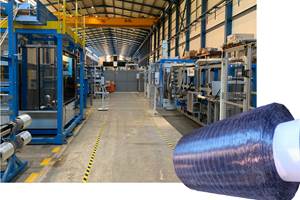NASA to build biggest composite rocket parts ever made
The robotic system is part of the Composites Technology Center at NASA’s Marshall Space Flight Center in Huntsville, AL.
One of the largest composites manufacturing robots created in America will help NASA build the biggest, lightweight composite parts ever made for space vehicles. The robot resides at NASA's Marshall Space Flight Center in Huntsville.
“Marshall has been investing in composites for a long time,” said Preston Jones, deputy director of Marshall’s Engineering Directorate. “This addition to Marshall’s Composites Technology Center provides modern technology to develop low-cost and high-speed manufacturing processes for making large composite rocket structures. We will build and test these structures to determine if they are a good fit for space vehicles that will carry humans on exploration missions to Mars and other places.”
NASA’s new Space Launch System required plenty of different materials. Lightweight composites have the potential to increase the amount of payload that can be carried by a rocket along with lowering its total production cost. NASA is conducting composites manufacturing technology development and demonstration projects to determine whether composites can be part of the evolved Space Launch System and other exploration spacecraft, such as landers, rovers and habitats.
“The robot will build structures larger than 8 meters, or 26 feet, in diameter, some of the largest composite structures ever constructed for space vehicles, “said Justin Jackson, the Marshall materials engineer who installed and checked out the robot and who helped build and test one of the largest composite rocket fuel tanks ever made. “Composite manufacturing has advanced tremendously in the last few years, and NASA is using this industrial automated fiber placement tool in new ways to advance space exploration. Marshall's investment in this robot will help mature composites manufacturing technology that may lead to more affordable space vehicles."
The robot is mounted on a 40-foot-long track in Marshall’s Composites Technology Center that is part of NASA’s National Center for Advanced Manufacturing. This center already has support infrastructure necessary for composite manufacturing: large autoclaves, curing chambers, test facilities and digital analysis systems.
To make large composite structures, the robot travels on a track, and a head at the end of its 21-foot robot arm articulates in multiple directions. The head can hold up to 16 spools of carbon fibers that look like pieces of tape and are as thin as human hairs. The robot places the fibers onto a tooling surface in precise patterns to form different large structures of varying shapes and sizes. In what looks like an elaborate dance, according to NASA, the tooling surface holds the piece on a rotisserie-like system on a parallel track next to the robot. The robot head can be changed for different projects, which makes the system flexible and usable for various types of manufacturing.
The first project that the robot will tackle is making large composite structures for a Technology Demonstration Mission (TDM) program managed by Marshall for the Space Technology Mission Directorate. For the project, engineers will design, build, test and address flight certification of large composite structures similar to those that might be infused into upgrades for an evolved Space Launch System.
The large structures built by the robot will be tested in nearby Marshall structural test stands where spaceflight conditions can be simulated.
"Composite materials are used across NASA projects for everything from aircraft to human space vehicles to planetary probes," said Larry Pelham, a Marshall composites expert who is leading manufacturing operations with the robot. “Robotic systems allow NASA to support a variety of research and development from low technology readiness levels to high technology readiness levels where structures are ready for flight tests."
NASA is a partner in the National/Interagency Advanced Manufacturing Initiative and will share its data with American companies to open up the marketplace for increased use of composites across a number of industries.
Related Content
Plant tour: Spirit AeroSystems, Belfast, Northern Ireland, U.K.
Purpose-built facility employs resin transfer infusion (RTI) and assembly technology to manufacture today’s composite A220 wings, and prepares for future new programs and production ramp-ups.
Read MoreNovel dry tape for liquid molded composites
MTorres seeks to enable next-gen aircraft and open new markets for composites with low-cost, high-permeability tapes and versatile, high-speed production lines.
Read MoreMaterials & Processes: Composites fibers and resins
Compared to legacy materials like steel, aluminum, iron and titanium, composites are still coming of age, and only just now are being better understood by design and manufacturing engineers. However, composites’ physical properties — combined with unbeatable light weight — make them undeniably attractive.
Read MoreMaterials & Processes: Fibers for composites
The structural properties of composite materials are derived primarily from the fiber reinforcement. Fiber types, their manufacture, their uses and the end-market applications in which they find most use are described.
Read MoreRead Next
CW’s 2024 Top Shops survey offers new approach to benchmarking
Respondents that complete the survey by April 30, 2024, have the chance to be recognized as an honoree.
Read MoreFrom the CW Archives: The tale of the thermoplastic cryotank
In 2006, guest columnist Bob Hartunian related the story of his efforts two decades prior, while at McDonnell Douglas, to develop a thermoplastic composite crytank for hydrogen storage. He learned a lot of lessons.
Read MoreComposites end markets: Energy (2024)
Composites are used widely in oil/gas, wind and other renewable energy applications. Despite market challenges, growth potential and innovation for composites continue.
Read More













.jpg;maxWidth=300;quality=90)












